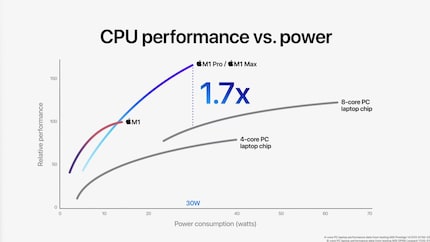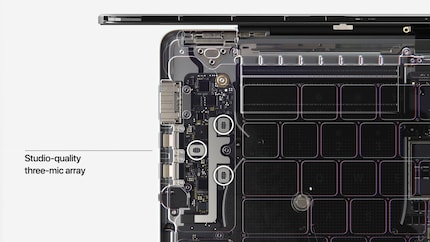
News + Trends
Apple introduces the 3rd Gen AirPods
by Livia Gamper

Apple didn’t present just one new CPU at its October event, but two. There’s also a new 16-inch Macbook Pro, the return of the MagSafe Charger, and a notched MiniLED screen.
At Apple’s October 2021 «Unleashed» event, CEO Tim Cook promised a lot. New Macbooks with unprecedented performance. Essentially, things have improved across the board. According to Cook, the new Macbooks are noteworthy for one thing above all else: their M1 Pro and M1 Max CPUs.
But first: did they really play the Doom soundtrack during the first minute of the livestream? Doesn’t matter, sounded good either way. Throughout the entire event. Apple is definitely cruising through October.
The new Macbook Pro chip is called M1 Pro, a CPU specifically dedicated to professionals. Senior Vice President of Hardware Engineering John Ternus mentioned app programmers. But video editors will also enjoy the new architecture. At least if the display is pre-calibrated accordingly. Apple still owes us some information.
By redesigning the M1 Pro, speeds have also increased. The device can now achieve up to 200 GB/s data transfer, handling 32 gigabytes of RAM. Its 10-core CPU is said to be up to 70% faster than the default M1. In addition, there are 16 graphics cores that are supposedly twice as fast as the integrated GPU on the M1.
Furthermore, hardware encoding for H.264 videos is on board. Will the M1 Pro be able to render 4k/60 fps in real time? Don’t know yet, but ProRes and ProRes RAW were at least announced.
To a few specific users, such as the aforementioned video editors, the M1 Pro still might not be fast enough. That’s where the M1 Max comes in. It’s even stronger than the already quite speedy M1 Pro, which in turn is faster than the current M1, all far ahead of the competition. At least, that’s what Apple’s show claimed.
The M1 Max supports up to 64 gigabytes of RAM, has a data transfer rate of 40 gigabytes per second and a 32-core GPU.
4k/60 fps in real time sounds extremely plausible.
Apple can’t let it go after all. Whereas concrete numbers in the description do provide a lot of information regarding the two new CPUs, there’s nothing on the graphics.

The power consumption stated along the X-axis is decent. Nothing much to say there. But the Y-axis highlights a problem. The description implies percentages. Still, nothing has been confirmed. The only thing I can read from it is «The M1 Max has 200». 200 what? 200 apples? 200 kilos? 200 cats’ noses?
Apple has finally arrived in the present with the Macbook Pro. The distance between the screen and actual physical edges of the device is thin. However, the installed webcam requires a notch. Still, said notch is the same size as macOS’ menu bar at the top of the screen. Thus, the notch takes up as little space as possible.

Apple has also come up with something new in terms of audio. However, we can’t say much before any proper review. Only this: the bass should be better, with six speakers now providing the sound.

Apple will set prices for its Macbooks between CHF 2199.– and 3849.– Exact prices outside the Apple Store may vary slightly, so these are just guidelines. Euro prices apply only to Austria, but are likely to be similar in Germany.
The devices should arrive on store and warehouse shelves around October 26th according to Apple.
It’s an open secret that Apple keynotes are as much tech demos as they are the company dramatising itself. I’d do the same if I had something like the M1 in my back pocket. Nevertheless, the sheer amount of marketing is quite staggering. Big enough to cast shadows over the raw performance numbers.
And that’s a shame, as these figures sound quite amazing already. Everyone knows it’s «the fastest Macbook ever» already. But the raw numbers make even real-time rendering a possibility. And all that without significant battery life loss? How? Is that even possible?
There’s only one way to get any answers: a test. Because if there’s one thing we pride ourselves on, it’s that we’re not overly impressed by marketing. Which is why we proudly proclaim: bring it on!
Something to end on: The track which played as the keynote was about to start was «Orck» by Gesaffelstein.
Journalist. Author. Hacker. A storyteller searching for boundaries, secrets and taboos – putting the world to paper. Not because I can but because I can’t not.
From the latest iPhone to the return of 80s fashion. The editorial team will help you make sense of it all.
Show all